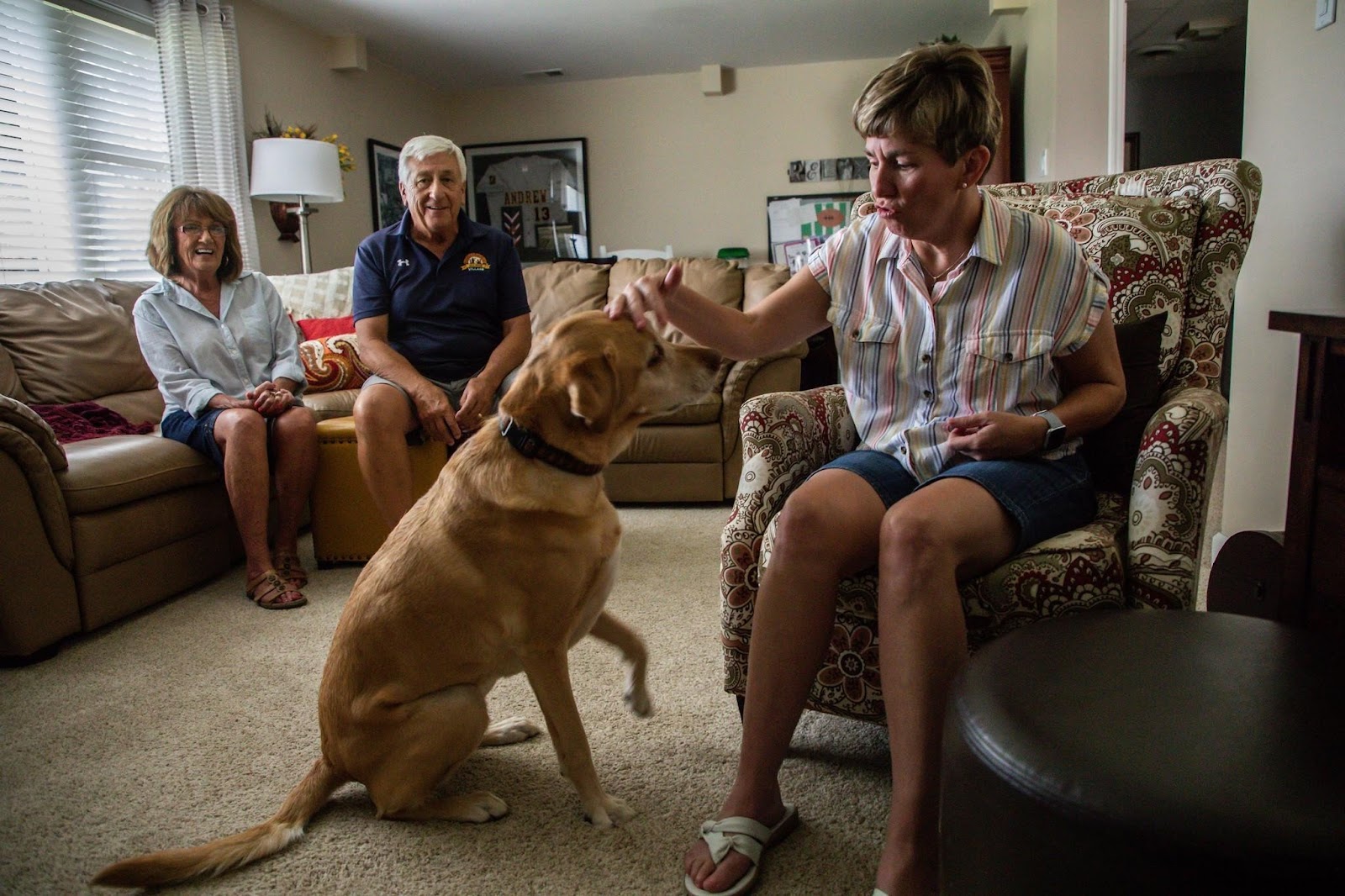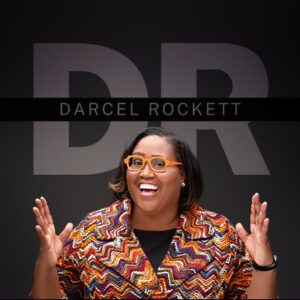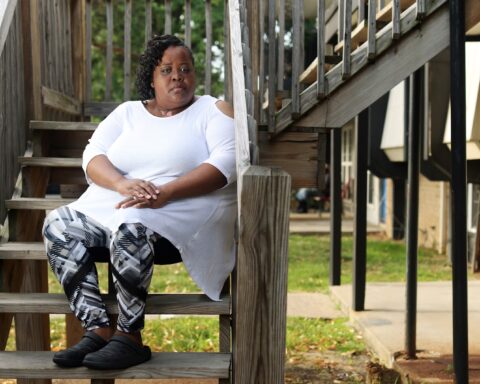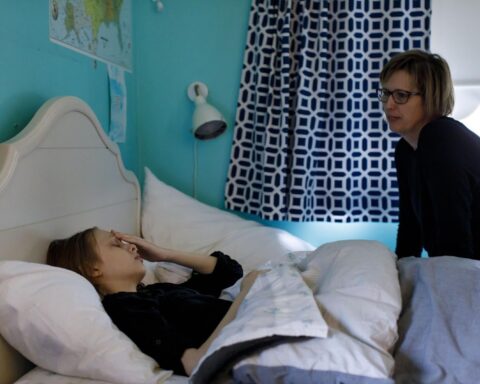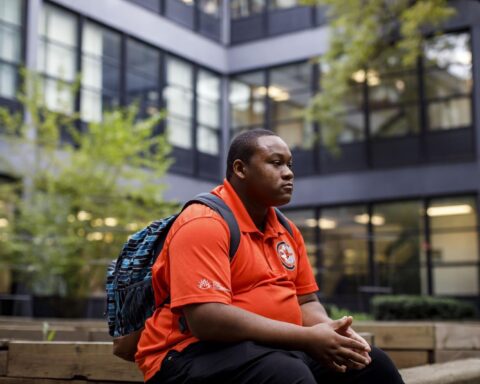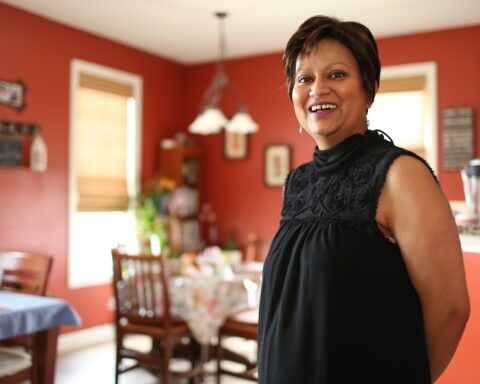It took Carie Ganser two years to learn colors.
“If you looked at her, she looked perfect,” said Linda of her middle child. “She was tested at 4 years old, but nothing came up. But looking back, all the red flags were there.”
Carie, now 44 and living with her parents in Tinley Park, was diagnosed with Autism Spectrum Disorder (ASD) in her early 30s. Linda knew something was different when Carie wasn’t meeting typical age benchmarks before starting kindergarten.
“She would come in and sit on her Sit’n Spin for a long time. … It was the only toy that was her favorite,” Linda said.
Thirty years ago, adults who had certain peculiarities were more likely diagnosed with Schizotypal personality disorder than ASD, according to Dr. Louis Kraus, medical director for Easter Seals Therapeutic Day Schools in Chicago and Tinley Park. The nonprofit has provided disability services for individuals and their families nationwide for 100 years.
“The diagnosis has always been one of process and change over time,” Kraus said. “I don’t think there’s any knowledgeable person in this area that would say that there weren’t more people undiagnosed a generation ago than there are now.”
First described by Dr. Leo Kanner in 1943, ASD affects 1 in 59 children, according to 2014 CDC data, a number that has risen steadily over time.
The increase is attributed to better diagnostic assessments and a wider scope of what constitutes ASD, such as Asperger’s syndrome, said Kraus, director/founder of the (Autism, Assessment, Research, Treatment and Services) Center at Rush University Medical Center. But he also noted that there are now more false positives, such as with speech and language issues that present as ASD.
Early diagnosis leads to better treatment, and diagnosing adolescents and adults can be complicated.
For example, at the AARTS (Autism, Assessment, Research, Treatment and Services) Center at Rush University Medical Center evaluations entail interviews with parents, caregivers and spouses, psychiatric testing for decision-making and processing, evaluating social interaction and communication, and observing atypical behaviors and sensory challenges, among other things.
In contrast, ASD in children can sometimes be detected at 18 months or younger with tests that gauge basic skills at certain age markers — how does the child interact, speak, listen and move. Doctors also deploy vision, hearing, genetic and neurological tests.
Nellie Moore, 58, knows all too well the complications that can accompany an adulthood diagnosis. Diagnosed four years ago, she attributes the delay to her parents’ inability to provide proper, consistent medical care, and a health care system that missed signs and symptoms.
Looking back, Moore recalls almost “jumping out of her skin” when any one of her three children came up behind her for a hug — pats on the back are uncomfortable too. Moore is very sensitive to external stressors such as sound and smell, and movement and communication can be difficult.
After a series of hospitalizations from 2008 to 2013, in which medical professionals diagnosed depression, PTSD and anxiety disorder, she still felt something was missing, so she started researching online.
It wasn’t until the former Hoffman Estates and Schaumburg resident read blogs of other late-diagnosed adults on the spectrum, particularly women, that she recognized herself. Further research about her family medical history, led her to ASD. Moore ultimately found a therapist who completed a patient intake evaluation that resulted in her official diagnosis.
“All my life, I’ve been masking and trying to pass in society and be someone who others thought I should be, and that’s pretty common for us on the spectrum,” said the current Hugo, Minn., resident. The diagnosis gave her permission to ask for help.
“It’s like we’ve been pushing against a wall for so long, trying to hold the wall up, and now we are backing away from the wall, dropping the pretense of needing to be someone else to get along in the world.”
As part of her diagnosis journey, and through therapy, Moore also came to terms with her sexual identity: She now identifies as bisexual/lesbian, something her husband and three children are aware of. Already overwhelmed by social situations and cues because of ASD — feeling “off” for much of her childhood — Moore said she put exploring her sexual identity on the back burner.
“Had I been diagnosed earlier, I might have had some tools to understand both myself, my parents and others, and recognize when relationships were unhealthy,” she said. “There’s much better resources for children. Unfortunately when you reach adulthood, you fall off the map. … It’s been a little over a year now since I received the diagnosis, and I’m coming out the other side. I know what’s going on, and I can take care of myself. I didn’t have those tools before, and I’m still learning.”
For Moore, that includes building a sensory toolkit — coping techniques to help calm her anxiety — like 20-pound weighted blankets that provide pressure and stabilize her jumpiness, noise-canceling or noise-deadening headphones, and quiet sensory toys (fidgets) that she holds to self-soothe.
Linda Ganser remembers the struggles that Carie endured growing up.
Teachers would call to complain about her lack of attention, rocking and parroting, a common ASD symptom in which people repeat others’ words or phrases without understanding the meaning. Carie got teased, struggled with schoolwork and took medication to help ease her symptoms.
Linda and her husband, Frank, a longtime high school baseball coach, kept seeking an explanation for why their daughter didn’t socialize with neighborhood kids like her other siblings. Doctor after doctor couldn’t provide an “answer that would fit,” she said.
They desperately tried to keep Carie engaged, but it wasn’t until a volleyball class with the Special Recreation program in Orland Park, at age 19, that things finally clicked. Before then, Carie’s only interest in sports was rooting for her father and siblings.
“I asked if I was doing the right thing, putting her into this, but after her first practice, I was driving her home, and she looks at me and says, ‘Thank you for signing me up for this, mom. I feel like I finally fit in.’”
Now Carie enjoys softball, basketball, tennis, soccer, cross-country skiing, bowling and swimming. She works at her neighborhood Jewel-Osco and participates in Special Olympics as an athlete, fundraiser and spokesperson. Photos of her philanthropic endeavors hang proudly around her parents’ bedroom.
“I like to try everything,” said Carie. Shy and quiet around new people, she smiles broadly when “Harry Potter” and “Twilight” movies are mentioned. And she loves her 5-year-old yellow Labrador, Annie, named after the movie.
“She’s always been very slow and purposeful,” Linda said of her pasta- and Candy Crush-loving daughter. “She’s far exceeded most expectations, and maybe that’s because we were hard on her.
“Our understanding, as it pertains to autism, has gone from a finite position to a spectrum disorder, so by definition, you’re going to have more people covered as a result,” said Jim Alviti, director of physical therapy and outreach services for Easter Seals DuPage & Fox Valley. “Our understanding of the special needs population and disability, in general, is far more sophisticated than it is when I walked through the doors 40 years ago.”
Debra Nauman’s son Riley was diagnosed with autism at 19 months old. At that point, the only reference she had about the condition was a late 1970s television movie in which a child continually spun plates.
“I had no clue,” she said. “He was diagnosed as a 1-in-10,000 births back in 1990 when he was born.”
Nauman, 60, has two sons on the ASD spectrum — Riley, 29, is nonverbal and needs help with daily activities like bathing and getting dressed; 16-year-old Christian Perez has a diagnosis of Asperger’s. Though Riley was diagnosed early (rarer for babies in the ’90s compared with today), Nauman saw a need for Riley and others like him and founded Giant Steps in 1996, a Lisle-based day school that provides educational, therapeutic and recreational programs for school-age children with ASD and the community.
Now, the single mother is focusing her attention on building up a new Sugar Grove-based day program for adults on the spectrum age 22 and older.
“These diagnoses are very real with the adult population,” Kraus said. “I think that’s where our knowledge has grown so much in the last decade, but there needs to be more training in professional and medical schools, and we need to get more funding to assist adults with autism.”
Canopy, an extension of Giant Steps, addresses post-school life with community outings and classes for life skills, vocational readiness, music therapy, physical activity and recreation.
“We cannot solve all problems, but we can lend our support,” Nauman said. “I don’t want my child warehoused someplace where he has absolutely no enjoyment in his life and he might as well be in jail. All I want for him is to be safe, happy and respected.”
